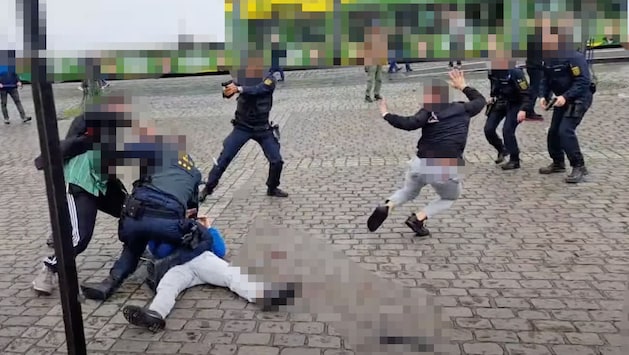Several people were injured, some seriously, in a knife attack in Mannheim. The footage is available online – and shows how important it is to provide quick first aid. We asked experts how you, as a layperson, should react correctly.
There is chaos on the town square in Mannheim, several people are lying on the ground and bleeding from stab wounds. Police officers are swarming around the injured. The time until the ambulances and emergency doctors arrive is agonizingly slow. But what seems like an eternity to a layperson is the normal time that passes until the emergency services arrive. First responders are left to their own devices for between seven and twelve minutes. That is the legally stipulated reaction time for the emergency services. But how should a passer-by react to an attack on the street? We asked an emergency paramedic.
Trigger warning: From this point on, we will clearly describe how to administer first aid in the event of a knife attack. There will be clear descriptions of blood and wounds that some readers may find disturbing.
No help without an emergency call. Therefore, no matter how many people are watching the situation, if you don’t hear anyone specifically making an emergency call, call 112 or ask another specific person. Calls like “We need an emergency doctor” usually go unanswered. The control center then asks for all the important information.
“If the attacker is still running around, you should hold back,” warns Anna Haufe (name changed by the editors), an emergency paramedic in Bavaria, “no one is helped if a brave helper becomes a victim himself.” Therefore, the following applies: observe, wait and only go to the injured when the situation is safe, the attacker has run away or is being held.
Critical bleeding can usually be recognized by the fact that blood spurts or flows out of the wound in a steady stream. “Injuries to the large blood vessels in the groin and thigh, in the abdomen, in the chest and in the carotid arteries are particularly serious,” emphasizes Haufe. Such a large loss of blood leads to death within a few minutes. This is why such a wound must be treated immediately: press firmly on the wound with both hands. Tying body parts with belts or scarves is not recommended for laypeople. “If pressing is not enough, as a last resort you can put your fingers in the wound and press firmly,” explains Haufe: “It is important that you really dare to touch the patient and press.”
By the way: If there is something left in the wound, do not remove it. This paramedic explains why in a short video on Instagram.
Bleeding from extremities, i.e. legs and arms, can also be stopped by holding them up. “In that case, you should still press, but also hold the arm or leg up,” explains Haufe. In this way, you can do a lot for an injured person even without any material. Incidentally, “Pressing a cloth or scarf onto the wound doesn’t help much,” emphasizes Haufe. In that case, it’s better to press with your hands or, if you have a first aid kit to hand, a sterile compress or wrapped gauze bandage.
Severe blood loss weakens the cardiovascular system, patients fall asleep or faint. As a first aider, you can make sure that you let the patient sit or lie down to support their circulation. “You have to imagine: you want the blood to flow away from the wound and towards the heart,” says Haufe.
For wounds in the upper body, a sitting position is best. “For this, someone kneels behind the patient and supports them. They can also take over care and pay attention to how the patient is doing,” explains Haufe. For wounds in the lower body, the classic position is to position the patient with the feet raised by pushing a backpack or several rolled-up jackets under the patient’s feet.
If the bleeding has stopped and the emergency services are not yet there, you should remember to keep the patient warm, even in summer: “If you sit on the floor, don’t move and are injured, you will cool down quickly,” stresses Haufe. The easiest way to do this is with a rescue blanket, which is light and fits in any handbag, but of course the jackets of those standing around will also do.
You can’t overestimate how important it is to care for an injured person, Haufe stresses: “Most injured people are in shock, don’t know what’s happening and what to do. A helper can calm them down, offer reassurance and answer questions – and always keep an eye on the injured person’s condition.” Good phrases when dealing with patients are “I’m here” or “We’ll do this together now.”
If an injured person is unconscious, he or she must lie in the recovery position. Unconscious means:
Breathing is monitored by observing the chest for at least ten seconds to see if it rises and falls. If the patient is breathing, place them in the recovery position, as this video explains:
If the patient is not breathing, resuscitation begins. “In many public places there are also defibrillators that can be operated by laypeople,” says emergency paramedic Haufe. This video shows what is important in resuscitation:
An important tip for all first responders: No one has to deal with an accident like this alone and it is often not easy to process what you have seen. If you need someone to talk to or advice on how to deal with the experience, call the telephone counseling service on 0800 111 0 111, the nearest trauma clinic, or the medical on-call hotline on 116 117, which also provides therapeutic help.


